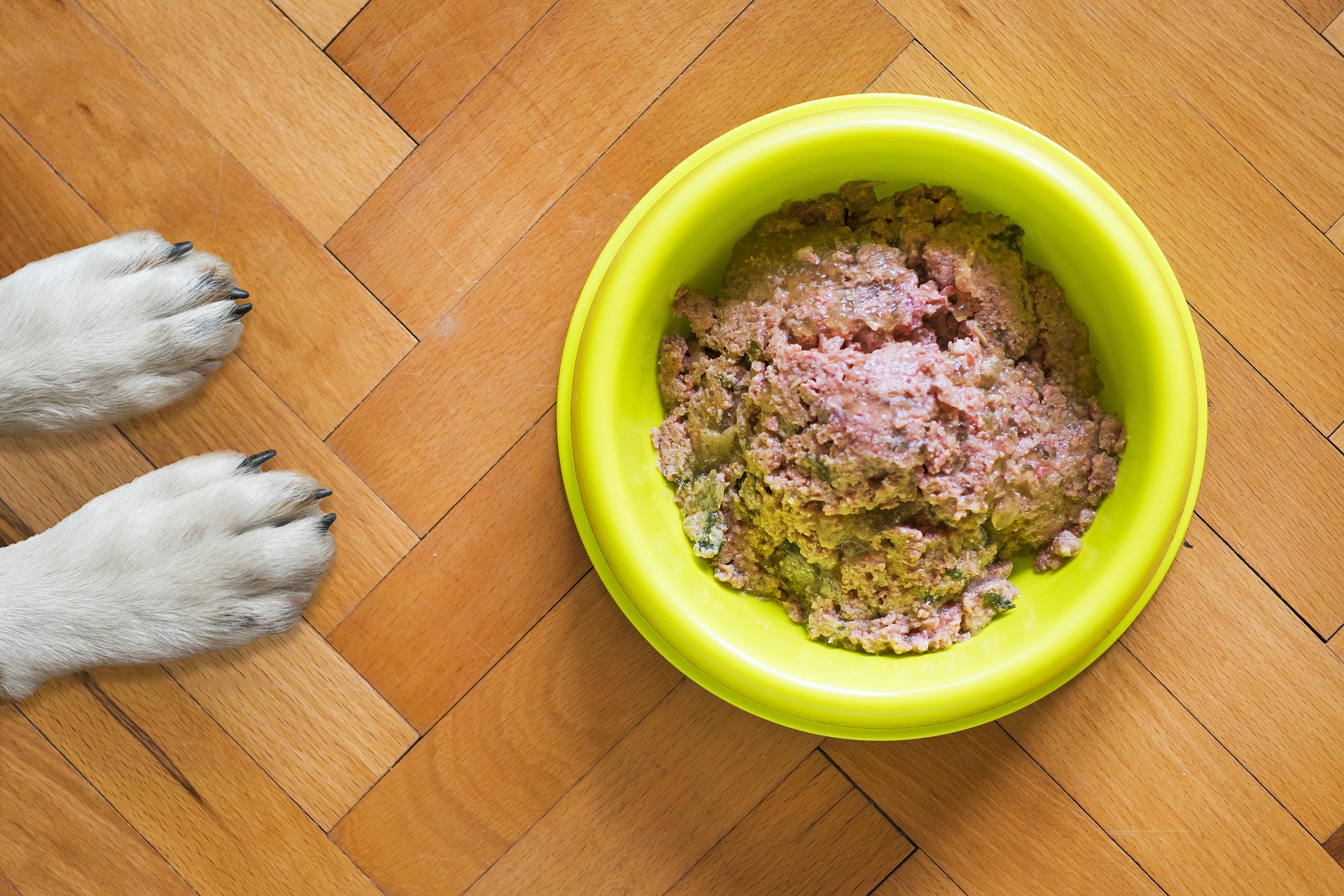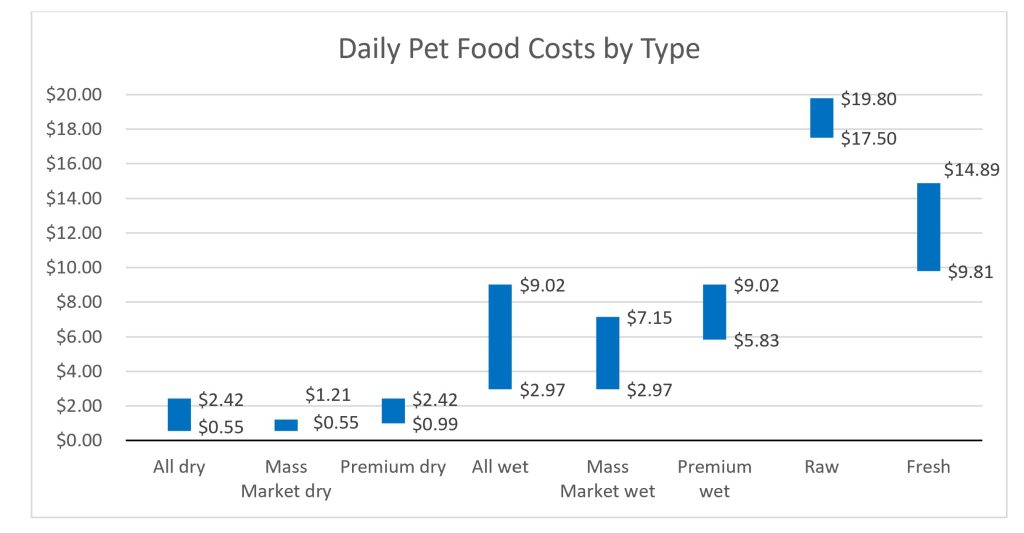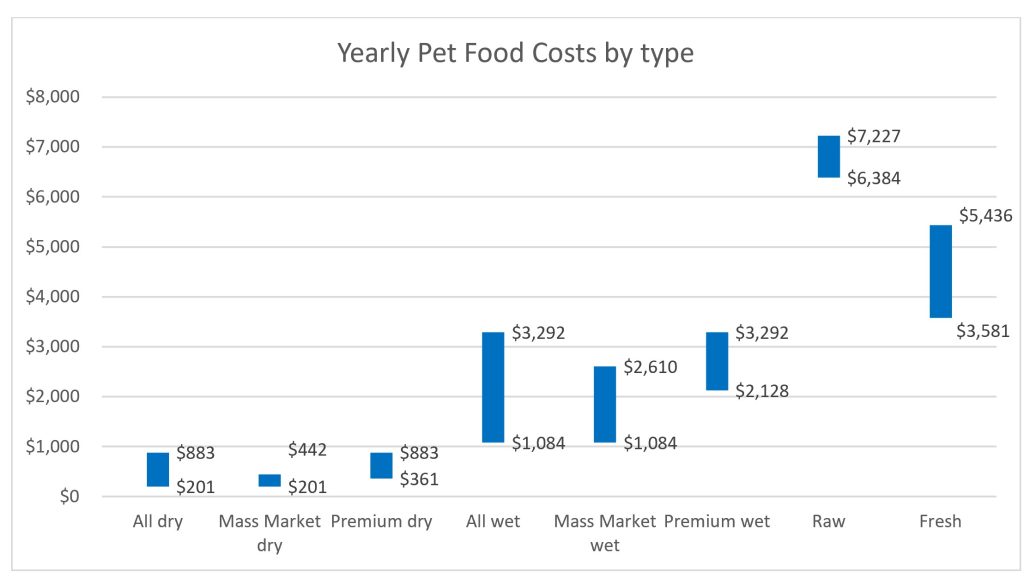
the scientific study of pet nutrition by veterinary nutrition specialists and experts.
Expensive eats? Comparing the costs of different types of dog food

I was recently teaching a group of veterinary students and we got into a discussion about the costs of various types of pet foods. Pet food costs are particularly relevant right now, when the costs of many consumer goods have increased rapidly in the last year, leaving many of us paying more for our food as well as that for our pets. US pet food and treat sales were around $42B in 2020 and estimated to top $44B when all the 2021 data is finalized.
We previously posted on estimating costs of pet foods and it seems like a great time to revisit the topic, this time focusing on the typical costs of feeding various types of pet foods. There are four main types or forms of commercial pet food: dry foods, wet foods (cans, pouches, tubs), fresh food (cooked and purchased fresh or frozen), and raw (frozen or freeze-dried). The costs for each type of food can vary dramatically!
How much can one expect to spend on the different types of dog food?
To get a better sense of current dog food expenses, I collected some data on the cost to feed certain types of dog foods to a hypothetical pet – a 55lb dog needing a very average 1100 kcal (1 kcal = 1 “human” Calorie) from food each day to maintain weight. I selected at least 3 diets from each category:
- Dry and canned mass market diets (these are foods available from retailers like Walmart, Target, and grocery stores)
- Dry and canned “premium” diets (these are foods available at large pet chains and pet boutiques)
- “Fresh food” diets (these are generally purchased on a subscription basis online directly from the manufacturer)
- Raw diets (I chose freeze-dried raw because they are shelf stable and sold at similar stores to the dry and wet foods). Note that we do not recommend raw feeding because of health risks to pets and people!
I picked diets that represented well-known, popular foods in each category, trying to select those that I perceived to be some of the most popular diets at both the bottom and top of the price range that I’ve seen for the category. I gathered pricing info from the websites of the stores where the diets would generally be purchased. I based the dry food prices on the bag closest in size to 30lb, as this is a common size to purchase for a medium-to-large dog and larger bags are often less expensive per pound than smaller ones. For cans, I based my calculations on cases of 12 when available, rather than individual cans, and always the biggest cans available (typically 12-13 oz). When possible, I selected the same brand of dry and canned food in each category for a more direct comparison.
I selected only foods marketed for adult dogs (puppy foods are often more expensive) and stuck with chicken or “original” flavors, to avoid increased costs from exotic meats or other ingredients and to allow for a better comparison. All of the products were at their regular price, none were on sale.
Here’s what I found in terms of costs to feed the average 55lb dog:
The daily costs ranged from 55 cents to nearly $20 for the same amount of calories! Some of the mass market dry and canned were quite a bit cheaper than the “premium” brands, but there was definitely overlap, especially for the canned foods. All of the dry food was less expensive than the alternatives, even though I included one of the most expensive popular dry foods.
The yearly costs ranged from $201 to over $7,000 – a pretty dramatic range! Feeding only wet food costs about 5 times as much as feeding only dry food, even when feeding the same food brands for both wet and dry. But both dry and wet foods are dramatically less expensive than fresh foods or raw foods – the fresh foods I surveyed (6 popular brands) cost 4 – 6 times what the most expensive dry food cost and 18-27 times more than the least expensive dry food! The highest price food cost about 36 times what the lowest priced food cost for a year!
Of note is the fact that the fresh food diets are shipped in small portions every few weeks while the raw diets are usually sold in small packages (< 3 lb), likely for logistical reasons like fridge/freezer space not to mention the sticker shock of paying >$700 for a 20lb bag of freeze-dried raw dog food, if it was available! With dry foods, the smaller the package, the higher the cost per calorie. So the smaller volumes and potentially more frequent purchases of these products may add some to the cost. But that clearly is not driving the huge difference in cost compared to dry and canned foods.
There are obvious limitations to this data – the dry, canned and fresh foods include only 6 products each, while the raw only 3 major brands. All were selected by me to be widely available and well-known rather than being randomly selected. However, I think that these diets are pretty representative of their categories based on my decade of experience working as a clinical nutritionist. There are definitely products available that are less and more expensive in each category than these examples, but they are generally going to be less common and less available. As an example, I just found a new fresh food diet this week that would cost over $1000 a month to feed to a 60 lb dog! But, I think these ranges give you an idea of what you can expect to spend right now for the various types.
Does a higher price = better health?
The obvious question to ask here is whether the higher cost is justified by better health for the dog. Will your dog be “36 times” more healthy if you feed the highest price diet versus the lowest? Unfortunately, it’s definitely not that simple! All of the diets that I used were “complete and balanced” meaning that they are unlikely to lead to any nutrient deficiencies and should be at the very minimum “adequate” diets to promote overall health. If money was tight, I would feed the lowest price diets I selected to my own dog without any concerns.
While many pet owners who feed more expensive diets of all types report improved health in their pets, these results likely represent the “marketing placebo effect” – when we spend a lot of money on something and/or expect a product to have a specific effect, we have a vested interest in convincing ourselves that it did what we expected and was a good value! Some pets may do better on some diets than on others, due to differences in digestibility, ingredients, fiber, etc. But that is comparing individual diets, not necessarily general types of food and doesn’t hold for all dogs like it does for individual dogs. The truth is that there are minimal scientific data to suggest a benefit of one of these diet types over others for an otherwise “average” healthy dog. In fact, there is plenty of evidence of potential health risks from raw diets, for both the pet and the pet’s family, despite this being the most expensive way to feed.
I encourage all pet lovers to select diets for their pets that fit comfortably into their family budgets. There is a good quality diet available at nearly every price point for a healthy pet. Try to ignore the powerful marketing for pet food and focus on the most important aspects of a food – the quality control and knowledge of the manufacturer and the suitability of the food to your pet and your lifestyle. Your veterinarian can help you sort out the best diets from the most heavily marketed so that you get a healthy diet that’s a good value for your money, regardless of your budget.
Picture by Matty Coulton and Pixabay
Want to read more information on feeding your pet?
Subscribe to always know when we add new material!
Recommended Posts

Can Diet Help With My Dog’s Seizures?
January 18, 2024

The Most Popular Holiday Foods…That Your Pet Should Avoid!
December 08, 2023

Veterinarian Recommended Pet Foods: What You Need to Know
November 05, 2023



